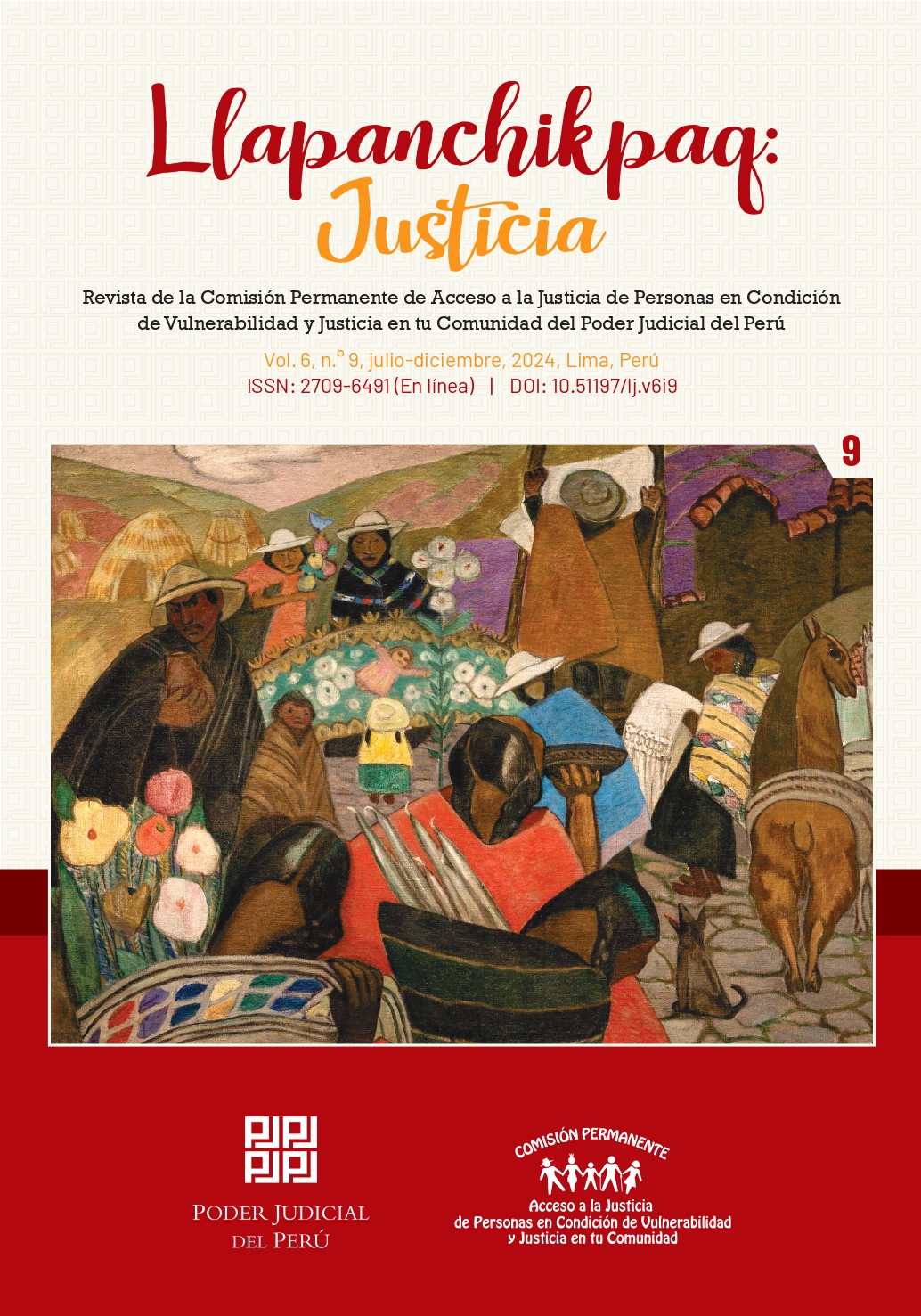Brasilia’s Rules for Youth in Jail: Application of The Brasilia’s Rules Trough the Crime Responsibility Restricted for Youth Secluded in Site Peruvian Jails
Abstract
The objective of this article is to analyze the application of Brasilia’s Rules through the crime responsibility restricted for young people between eighteen and twentyone years old. In such a way that it could contribute to reducing the excessive population in site Peruvian jails and guarantee the human rights for them. Therefore, will present the theoretical development about Brasilia’s Rules, crime responsibility restricted; statistics made by the Instituto Nacional Penitenciario about criminal population and the judgment made by the Constitutional Court of Peru about the excessive population in site Peruvian jails. Those help to understand the importance to applicant the Brasilia’s Rules to eradicate vulnerable conditions for young people in site Peruvian jails. That through the use of a legal tool such the crime responsibility restricted and some change in the rule help to reduce the excessive population in the Peruvian jails harmonizing with the human rights of people private of them freedom.
Downloads
Metrics
References
Acceso a la Justicia y las 100 Reglas de Brasilia (2016) [Video conferencia]. En Aula Virtual del Poder Judicial. https://youtu.be/e8NEqX3qdBo?si=_3YhXQqKH3BeZP_D
Acuerdo Plenario n.o 42016/CIJ116. Diario Oficial El Peruano (2016). https://img.lpderecho.pe/wpcontent/uploads/2021/05/AcuerdoPlenario42016CIJ116LP.pdf
Arias, D. (2012). Proporcionalidad, pena y principio de legalidad. Revista de Derecho. (38), 142 171. ISSN 01218697. https://hdl.handle.net/10495/3143
BramontArias, L. (1998). Manual de Derecho Penal. Parte General. Editorial Santa Rosa.
Carnevali, R. (2008). Derecho Penal como última ratio. Hacia una política criminal racional. Revista Ius et Praxis, 14(1), 1348. ISSN 07180012. http://dx.doi.org/10.4067/s071800122008000100002
Casación n.o 1057Cusco (2017). Corte Suprema de Justicia de la República, Sala Penal Permanente. https://static.legis.pe/wpcontent/uploads/2018/11/Casación10572017CuscoLegis.pe_.pdf
Casación n.o 1672Puno (2017). Corte Suprema de Justicia de la República, Sala Penal Permanente. https://static.legis.pe/wpcontent/uploads/2018/10/Casacion16722017PunoLegis.pe_.pdf
Casación n.o 214El Santa (2018). Corte Suprema de Justicia de la República, Sala Penal Permanente. https://www.pj.gob.pe/wps/wcm/connect/5b65bb80484922ba95a99da38f54faeb/CSSPPRC2142018ELSANTA.pdf?MOD=AJPERES& CACHEID=5b65bb80484922ba95a99da38f54faeb
Constitución Política del Perú. (1993). Sistema Peruano de Información Jurídica. https://www.web.onpe.gob.pe/modElecciones/elecciones/MarcoLegal/constitucionpoliticaperu1993.pdf
Consulta n.o 13848 Huara (2016). Corte Suprema de Justicia de la República, Sala de Derecho Constitucional y Social Permanente.
Decreto Legislativo n.o 635 (2019). Código Penal Peruano. Jurista editores.
Expediente n.o 54362014PHC/TC (2020). Tribunal Constitucional (26 de mayo de 2020).
Ferrajoli, L. (2016). Jurisdicción y Ejecución Penal. La cárcel: una contradicción institucional. Revista Crítica Penal y Poder, (11), Observatorio del Sistema Penal y los Derechos Humanos: Universidad de Barcelona. https://revistes.ub.edu/index.php/CriticaPenalPoder/article/view/16783
García Ramírez, S. (2007). Ruth Villanueva: Los menores infractores en México. Boletín Mexicano de Derecho Comparado, 1(119). https://doi.org/10.22201/iij.24484873e.2007.119.3927
Informe de Adjuntía n.o 0062018DP/ADHDP. Retos del Sistema Penitenciario Peruano: un diagnóstico de la realidad carcelaria de mujeres y varones. Defensoría del Pueblo. https://www.defensoria.gob.pe/wpcontent/uploads/2019/04/Retosdelsistemapenitenciario.pdf
Informe Estadístico Enero 2023. Instituto Nacional Penitenciario. https://siep.inpe.gob.pe/Archivos/2023/Informes%20estadisticos/informe_estadistico_enero_2023.pdf
Informe sobre derechos humanos de las personas privadas de libertad en las Américas. (31 diciembre 2011). Comisión Interamericana de Derechos Humanos. Doc. 64. https://www.oas.org/es/cidh/ppl/docs/pdf/ppl2011esp.pdf
Jiménez, J. (2016). Manual de Derecho Penal Informático. Jurista editores.
Organización Mundial de la Salud (2019). Salud del adolescente. https://www.who.int/es/healthtopics/adolescenthealth
Reglas Mínimas de las Naciones Unidas para el Tratamiento de Reclusos (Reglas de Nelson Mandela) (17 de diciembre de 2015). https://www.unodc.org/documents/justiceandprisonreform/Nelson_Mandela_RulesSebook.pdf
Resolución Administrativa n.o 2662010CEPJ. (2010). (26 de julio de 2010).
Resolución Administrativa n.o 0282016CEPJ. (2016). (3 de febrero de 2016).
Resolución Administrativa n.o 1982020CEPJ. (2020). (30 de julio de 2020).
Roxin, C. (1997). Derecho Penal, Parte General Tomo I. Fundamentos, la estructura de la teoría del delito. Civitas.
Sentencia Plena Casatoria n.o 012018/CIJ433 (2018). Corte Suprema de Justicia de la República (18 de diciembre de 2018). Solano, F. y Mejía, D. (2021). La responsabilidad restringida por edad en la determinación de la pena en el proceso inmediato en el distrito judicial de Junín 2020. https://renati.sunedu.gob.pe/handle/sunedu/3616229?locale=es
Vázquez, D. & Ortiz, H. (2020). Impunity and Economic and Social Rights. Human Rights Review, 21(2), 159180. https://doi.org/10.1007/s12142020005803
Villavicencio, F. (2014). Derecho Penal. Parte General. Jurídica Grijley E. I. R. L.
XIV Cumbre Judicial Iberoamericana. Reglas de Brasilia sobre el Acceso a la Justicia de las Personas en Condición de Vulnerabilidad (4 al 6 de marzo de 2008). Brasilia.
XIX Cumbre Judicial Iberoamericana. Reglas de Brasilia sobre el Acceso a la Justicia de las Personas en Condición de Vulnerabilidad (18 al 20 de abril de 2018). San Francisco de Quito.
Copyright (c) 2024 Luis Alberto Ramirez Tipacti

This work is licensed under a Creative Commons Attribution 4.0 International License.
The authors retain their copyrights and register under the Creative Commons Attribution 4.0 International License (CC BY 4.0), which allows the use of the published material (adapt - remix, transform and build - and share - copy and redistribute - the material in any medium or format).
a. The journal allows authors to retain their copyright of submitted articles without any restrictions.
b. Authors retain the right to share, distribute, copy, perform and publicly communicate the article published in Llapanchipaq Justicia (e.g., place it in an institutional repository).
c. Authors retain the right to make a subsequent publication of their work, to use the article or any part of it (for example: a compilation of their work, notes for conferences, thesis, or for a book), as long as they indicate the source of publication (authors of the work, journal, volume, number and date).
















